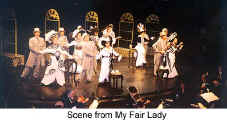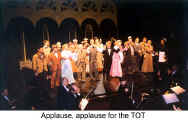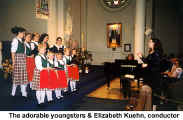
Musical Fare par Excellence
by Sybille Forster-Rentmeister
The month of May is traditionally rich with spring concerts and other musical performances. We attended four of them within five days.
 The
start was made in St. James Cathedral where "Bach and Blues"
performed to raise funds for a new synagogue in Dresden. The synagogue was
deliberately set on fire during the famous "Kristallnacht" and the
fire department was forbidden to interfere. Some daring firemen nevertheless
salvaged the Star of David from the top of the building, hid it, and
returned it to a much shrunk Jewish community after the war. Now that the
Jewish community is counting over 300 hundred members again there is much
need for a new synagogue. The planned new building is to have two parts: the
synagogue and a community centre, where members can also be taught.
The
start was made in St. James Cathedral where "Bach and Blues"
performed to raise funds for a new synagogue in Dresden. The synagogue was
deliberately set on fire during the famous "Kristallnacht" and the
fire department was forbidden to interfere. Some daring firemen nevertheless
salvaged the Star of David from the top of the building, hid it, and
returned it to a much shrunk Jewish community after the war. Now that the
Jewish community is counting over 300 hundred members again there is much
need for a new synagogue. The planned new building is to have two parts: the
synagogue and a community centre, where members can also be taught.
Arranged was this concert by the Consulate General of the Federal Republic of Germany and the Goethe Institute. The three artists who founded their trio in 1980 in Dresden were happy to lend a hand with their music for this cause. All three of them have impeccable musical abilities, as we reported in the pre-announcement, but no one was prepared for such a tour de force. The cathedral was resounding in the glorious sounds of Bach and some of their own compositions.
Unfortunately the concert was not as well visited as one would wish for, and the offering did get applause, but not the exuberant responses it deserved. A mainly conservative audience politely applauded each piece, except for some of our friends, who could not suppress a few exhilarating bravo calls and "Juchtser".
Perhaps it was the intimidating interior of the church that held the audience back from expressing appreciation appropriately, perhaps most of them did not understand how Bach and jazz combined in one concert are an ideal combination. Yet, if Bach and jazz don’t go together, which composer would lend itself better to it? There is no doubt that Bach is the father of much our favourite styles of music. He codified all possible combinations of sound for musical instruments. Without him the world would be much poorer. No doubt he would rejoice in the efforts of Friedrich Sternberg, no relation to the famous film director, we asked, Goetz Bergmann and Ulrich Thiem.
At a reception held at the Goethe Institute afterwards the audience delighted in meeting the artists in person and close up. While munching on delicious hors d’oeuvres and sipping some fine German wine and champagne conversations were animated.
It was a short visit for the artists, but a worthwhile one.
My Fair Lady
Only one day later, on May 6, the Toronto Operetta Theatre’s spring production of My Fair Lady had opening night. It was a way down memory lane for us. Remembering the original film version when it first came out in Germany, and not having seen it since on stage or on screen, we were full of anticipation. The rich setting and costumes still burned into our memory made us wonder how the TOT would cope and compete with our expectations. But we were pleasantly surprised. While it is never good or fair to compare one medium with another, especially concerning the same piece of art, our memories do play awesome tricks with us. In this instance the transition worked so well that none of us felt even the least bit put out by the lack of lavishness. The small stage of the Jane Mallet Theatre was filled with lively artists in well-chosen costumes that recreated the scenes still so vivid in our minds. And what was not there was easily blocked in by our imagination.
 Not
one scene went by without one of the famous songs that we have heard again
and again over the years on the radio, which we could sing along in an
instant. That phenomenon alone carried the fast paced show forward. The rest
was accomplished by utilizing a simple yet versatile set. The rearranging of
the basic elements was in itself a little artistic production, executed with
splendid precision, almost perfectly in tune with the bridging music.
Not
one scene went by without one of the famous songs that we have heard again
and again over the years on the radio, which we could sing along in an
instant. That phenomenon alone carried the fast paced show forward. The rest
was accomplished by utilizing a simple yet versatile set. The rearranging of
the basic elements was in itself a little artistic production, executed with
splendid precision, almost perfectly in tune with the bridging music.
Versatile Giselle Fredette conjured up a very "common" Eliza with a broad and vulgar accent. She was, perhaps because of it, even more touching as the transformed and newborn lady who mastered "the rain in Spain" beautifully with much aplomb. Despite the social polish she remained vulnerable, yet not without cunning- well fortified by Rosemary Radcliff as Mrs. Higgins.
 Every
performer was well suited for their role. Curtis Sullivan as the pompous
bachelor professor, who knows obviously nothing about women or his own
emotional depth, sang his role wonderfully. The film version made us believe
that this part was more spoken than sung, but in this production we learned
to appreciate the musical score even more. It also did not hurt that this
performer is much better looking than his famous college from the film
production.
Every
performer was well suited for their role. Curtis Sullivan as the pompous
bachelor professor, who knows obviously nothing about women or his own
emotional depth, sang his role wonderfully. The film version made us believe
that this part was more spoken than sung, but in this production we learned
to appreciate the musical score even more. It also did not hurt that this
performer is much better looking than his famous college from the film
production.
Gregory Cross delivered a gregariously funny Doolittle. His huge frame was amazingly light and mobile. He found just the right amount of clever cajoling to keep everyone laughing and made the transition to regular burger without a hitch.
John Weir as Colonel Pickering, the retired British Officer, was polished and accomplished in every gesture, every move.
Keith Boldt as Freddy, Eliza’s other suitor, sang technically well, but lacked a certain quality that would make us believe completely that he was head over heals in love with Eliza, especially in view of the other very strong performances.
The other smaller parts all delighted and the ensemble performed the many lightly choreographed numbers with ease. The 13-piece orchestra under the baton of Peter Oleskevich sounded rich and colourful.
This offering of the TOT was definitely a crowd pleaser and also held up to high artistic standards.
In June we can look forward to Leo, The Royal Cadet with Alexandra Lennox, Eric Shaw and the incomparable Bruce Kelly. Performances run from June 26, preview, June 27, opening night, a matinee on the 28th, and regular performances on June 30 and July 1st.
Austrian Spring Concert
 On
Sunday, May 7, the Mixed Coir Edelweiss gave an afternoon concert in the St.
Patrick’s Church. At first the church did not look too filled, but in the
course of the performance more people arrived. The choir has a new
conductor.
On
Sunday, May 7, the Mixed Coir Edelweiss gave an afternoon concert in the St.
Patrick’s Church. At first the church did not look too filled, but in the
course of the performance more people arrived. The choir has a new
conductor.  George
Zaduban took over earlier in the year. Choir fans are familiar with his work
from at least 2 other choirs. His lifelong expertise and famous patience
worked also wonders with this choir. It was immediately apparent that in his
care the choir has advanced to another level. Throughout the performances
more distinguishable differences became clear. As a photographer works with
light and shadow music relies on the interplay of forte, strong, and
pianissimo, very soft, and everything in between. This helps the
interpretation of the emotional impact, which a song has to create,
tremendously. The choir is much more expert at this differentiation now than
ever before. Accordingly the songs performed were much more lively. The
opening Alleluja, sung together with the guest choir St. Elisabeth Scola
Cantarum illustrated this admirably. And when the Edelweiss Choir then sang
their beloved Austrian folksongs we were spirited away across the ocean to
the old country.
George
Zaduban took over earlier in the year. Choir fans are familiar with his work
from at least 2 other choirs. His lifelong expertise and famous patience
worked also wonders with this choir. It was immediately apparent that in his
care the choir has advanced to another level. Throughout the performances
more distinguishable differences became clear. As a photographer works with
light and shadow music relies on the interplay of forte, strong, and
pianissimo, very soft, and everything in between. This helps the
interpretation of the emotional impact, which a song has to create,
tremendously. The choir is much more expert at this differentiation now than
ever before. Accordingly the songs performed were much more lively. The
opening Alleluja, sung together with the guest choir St. Elisabeth Scola
Cantarum illustrated this admirably. And when the Edelweiss Choir then sang
their beloved Austrian folksongs we were spirited away across the ocean to
the old country.
 The
St. Elisabeth Scola Cantarum Choir sang at first some well chosen classical
pieces, all very difficult, with much discipline and some beautiful voices,
one of them being the conductors own daughter, who is becoming a popular
singer in the modern music scene with a group and a recording contract. In
the second half of the concert the choir offered two lively Hungarian
selections to much applause.
The
St. Elisabeth Scola Cantarum Choir sang at first some well chosen classical
pieces, all very difficult, with much discipline and some beautiful voices,
one of them being the conductors own daughter, who is becoming a popular
singer in the modern music scene with a group and a recording contract. In
the second half of the concert the choir offered two lively Hungarian
selections to much applause.
 In-between
the Children-Youth Choir Edelweiss showed off what they had learned under
the direction of the talented Elisabeth Kuehn. Of course everyone is
delighted with the efforts of the very young. Always astounding is how
In-between
the Children-Youth Choir Edelweiss showed off what they had learned under
the direction of the talented Elisabeth Kuehn. Of course everyone is
delighted with the efforts of the very young. Always astounding is how ![]() Caroline
Kuehn remains a stable support for this small group and how she never fails
to be a team member among the children despite the fact that she has grown
to be a talented solo performer. In two selections by Mahler and Schubert
she demonstrated a repertoire growing in difficulty, which she mastered
admirably.
Caroline
Kuehn remains a stable support for this small group and how she never fails
to be a team member among the children despite the fact that she has grown
to be a talented solo performer. In two selections by Mahler and Schubert
she demonstrated a repertoire growing in difficulty, which she mastered
admirably.
 The
absolute highlight of the afternoon was without a doubt the performance of
Ursula Ivanoffski. Her bright soprano and personable style reached
throughout the church into every ones heart and mind. "Klänge der
Heimat" by J. Strauss and Mahler’s „Liebst um Schönheit" was
followed by Lehar’s „Vilia". The audience was allowed to
participate in this all time favourite. This is very welcome after having
listened to so many songs. As the music flows into our minds and souls it
must also flow out.
The
absolute highlight of the afternoon was without a doubt the performance of
Ursula Ivanoffski. Her bright soprano and personable style reached
throughout the church into every ones heart and mind. "Klänge der
Heimat" by J. Strauss and Mahler’s „Liebst um Schönheit" was
followed by Lehar’s „Vilia". The audience was allowed to
participate in this all time favourite. This is very welcome after having
listened to so many songs. As the music flows into our minds and souls it
must also flow out.
Every one was rewarded with much applause and the soloists of course received a bouquet of flowers.
Afterwards, as is customary, every one congregated in the churches community hall for the generously donated coffee and cake.
We are looking forward to the choir’s next performance.
Choral Ecstasy
On Tuesday, May 9th, we held our pilgrimage to Massey Hall where the Toronto Mendelssohn Choir performed its last subscription concert. Russian composer Stravinsky’s Symphony of Psalms that was commissioned by the Boston Symphony for its 50th anniversary, opened the concert. The world premier of this extraordinary work took place in Brussels on December 10th, 1930. Much like the composer the music is lean, not ornamental, as was usual for this kind of score. Three parts are played without pause. The treatment relies mainly on counterpoint, giving choral and instrumentation equal attention. The style is austere and objective rather than heavily burdened with emotional innuendo designed to cause listeners to go into religious reverie. Without violins and violas strings are only used to fill out tonal structure, causing the listener to stay alert and soar on different wings to another kind of ecstasy.
This was followed by another modern composition, French composer Poulenc’s Gloria. Here too the audience responded to unusual grace of tonal quality, with uplifting, pleasant harmonies that took unexpected turns.
After the intermission Beethoven’s Ninth Symphony rounded out the program. This much more familiar work never ceases to amaze audiences. Right from the start an atmosphere of awe is created. The feeling of an all-encompassing humanity, spirituality and exaltation builds throughout this work, until it reaches its pinnacle with the Ode To Joy at the end. There is no music that so much intoxicates. And even though some critics felt that works like this should not be performed by a choir of this proportion and with less than a well known and grooved in Symphony orchestra, the attending audience would not have missed this symphony with its perfect proportions, so overwhelming with passion and intensity, full of the struggle of the human spirit, with which we are all so familiar with. In the finale Beethoven enlists the help of four soloists and the chorus. Mark DuBois, tenor, Linda Maguire, mezzo, Rebecca Caine, soprano and Mark Predotti, bass, added with their accomplished voices a special exaltation. And when the Ode to Joy finally resounded through the hall the audience was overwhelmed by its beauty. There was a hush before the almost unending applause.
Noel Edison, the conductor, was exhausted but very happy. It was a special treat to observe him conducting these fine works.
Watch out for the Mendelssohn Choirs upcoming season later in the year.
Comments to: sfr@echoworld.com
